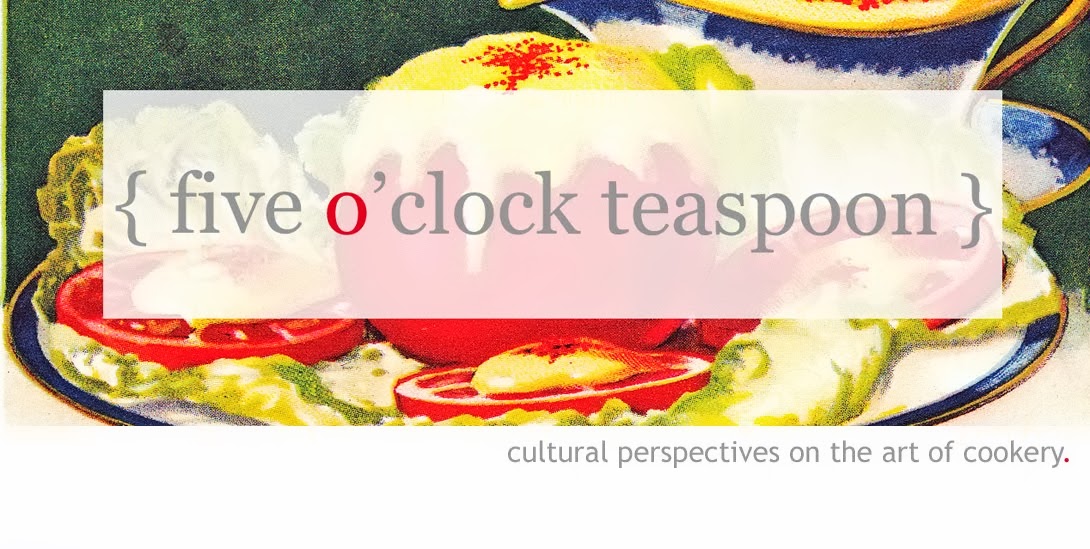Depending on the particular flavor of straitened social circumstances for which the cookbook was written (frontier life, war, inflation, unemployment), one will find a particular worldview that shapes the cooking process. These books are written for a swathe of the population who experience poverty through a shared outside influence. The author is a comrade, one who has managed to live comparatively well in the same situation. Why then, when food prices are just as high as ever, with worrisome unemployment figures, and "food deserts" threatening the nutrition and well-being of much of the U.S. population, has the genre all but disappeared? Many of these older books are still talked of on blogs and in news pieces; people still find their information relevant. In terms of their philosophy toward food, their closest counterparts are Alice Waters-like cookbooks on cooking with fresh, seasonal ingredients. But such examples are not typically written with budgets and scarcity in mind.
To see how the genre has changed, I'll take a look at some distinctive examples from the second half of the 20th century into the 21st century. What are your favorite money-saving cookbooks?
How To Cook a Wolf by M.F.K. Fisher
Published in 1942, How To Cook a Wolf speaks to a people struggling during war time. The people were Americans and although their domestic sovereignty was not ultimately violated, ration books and blackouts brought an unsettling change to everyday life. When Wolf was published, Mary Frances Kennedy Fisher (1908-1992) was already known for her fluid, conversational writing in which recipes would materialize without warning, intelligently wrapped up in the middle of anecdotes, like the surprise cream center of a truffle.
If you think eggs boiled in their shells are fit for the nursery, and refuse to admit any potential blessing in one delicately prepared, neatly spooned from its shell into a cup, sagely seasoned with salt and fresh-ground black pepper and a sizable dollop of butter, all to be eaten with hot toast, then it is definitely not your dish.
 |
| M.F.K. Fisher by Ginny Stanford, 1991. Acrylic and silver leaf on canvas. National Portrait Gallery, Smithsonian Institution. |
Like Elizabeth David and Julia Child, Fisher's approach to food was shaped by travel in France and other European countries. Her message is simple: down with food snobbery and ignorance; embrace fresh ingredients and the wisdom of the soil. In her revised text for the 1951 edition of Wolf Fisher offers the most eloquent statement on food sovereignty I have ever read. In a moment of prolepsis, she captures the post-war shifts in agricultural production and anticipates the struggles of what would become the organic, sustainable, non-GMO, and slow food movements :
I believe more firmly than ever in fresh raw milk, freshly ground whole grains of cereal, and vegetables grown in organically cultured soil. If I must eat meats I want them carved from beasts nurtured on the plants from that same kind of soil. As for fish...they can choose their own way of life in my gastronomy, unless we interrupt it with split atoms.
_________________________
Fisher believes in a common sense approach to eating. She has no patience for three-meals-a-day nutrition plans or food pyramids. Soup and buttered toast make a very fine meal, the addition of a baked apple with or without cinnamon milk, sublime. Leftovers are another treasure trove as fuel- conscious cooks could make large batches that would maximize the energy needed to run the stove, oven, or refrigerator. Leftover spaghetti is dressed up with honey and almonds for a comforting dish.
M.F.K Fisher's Baked Apple, adapted from How to Cook a Wolf
I'm not a big fan of raisins but they are excellent in this dish. Really stuff the apples with as many raisins as you can, and don't be stingy with the butter. The recipe is easily doubled, tripled, etc.
Serves 2
2 apples, cored
4 Tbs brown sugar
1/4 to 1/3 cup raisins
Butter
Cinnamon
Nutmeg
1. Preheat oven to 400°F. Put raisins in a bowl and dust with cinnamon and a sprinkle of nutmeg. Place apples in a baking dish. Stuff center with spiced raisins and a couple of spoonfuls of butter. Drop spoonfuls of the brown sugar in the baking dish and pour in water until it reaches about 3/4 up the sides of the baking dish. Bake until the apples are meltingly soft, at least an hour. Serve with cinnamon milk.
Cinnamon Milk, adapted from How to Cook a Wolf
1 pint milk
1 tsp cinnamon or mixed spices
1 Tbs butter
Heat milk in a double boiler. Add spices and butter. Pour into heated jug and serve like cream.
Spaghetti with Honey and Almonds, adapted from How to Cook a Wolf
Leftover spaghetti
Slivered almonds, toasted
Honey
To plain, leftover spaghetti add toasted almonds and a generous stream of honey. Either heat together in a pot on the stove or broil in the oven until toasty.
As a note on cooking pasta, Fisher recommends adding a little butter to the salted boiling water. It helps the spaghetti strands remain autonomous and slippery and adds a pleasant flavor. Less fat is then needed when dressing the pasta after draining. I used to do this with oil, but the butter is far superior.
_________________________
With Fisher's characteristic flair, the final chapter offers not a parting token of thriftiness but rather the opposite. Sometimes in order to survive hunger, one has to remember what good food was like. And so "How to Practice True Economy" includes recipes of luxury, rife with ingredients that were unobtainable to most during WWII: Shrimp Pate, Eggs with Anchovies, Boeuf Moreno, Poulet à la Mode de Beaune, and Fruits aux Sept Liqueurs.
Close your eyes to the headlines and your ears to sirens and the threatenings of high explosives, and read instead the sweet nostalgic measures of these recipes, impossible yet fond.




